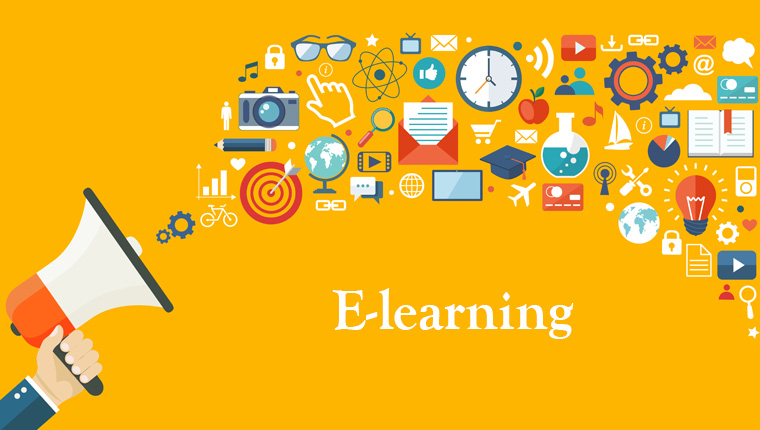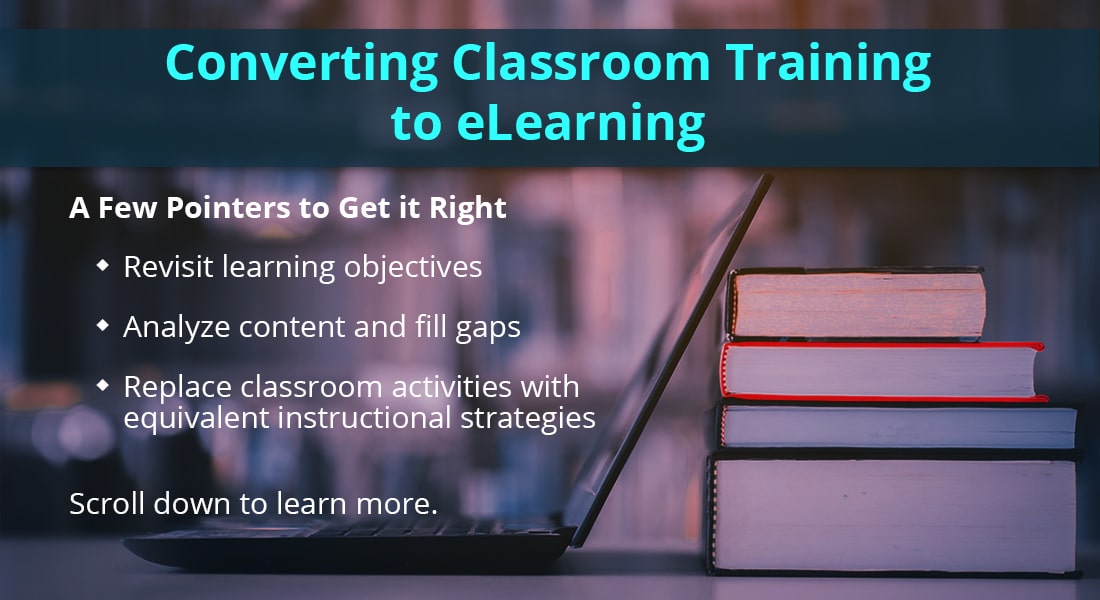A Comprehensive Guide to eLearning Activities

"Set clear learning objectives” is a phrase you must have heard multiple times in the process of learning about designing effective eLearning courses. In simple terms, learning objectives specify what learners will be able to do by the end of the training. Setting the right LOs helps in structuring your eLearning course – involves determining the appropriate content, interactivities, assessments, among others –which is the instructional strategy, or as William Horton in his book E-learning by Design puts it, ‘learning activities’.
3 Categories of E-learning Activities You Should Know About
Absorb activities
- Video-based Learning
- Storytelling
- eBooks and PDFs
Do Activities
- Branched Scenarios
- LEAD
- Simulations
Connect Activities
- Job-aids
- Collaborative eLearning
Horton discusses three types of learning activities – Absorb, Do, and Connect that can help accomplish learning objectives.
- In Absorb activities, learners absorb knowledge by observing, listening, or reading. They are physically passive but mentally active.
- In Do activities, learners do something with the knowledge acquired by means of practice, exploration, and discovery.
- In Connect activities, learners link to prior knowledge and apply what they have learned– skills and knowledge – to their work.
While in Absorb and Do activities, learners learn something new, in Connect activities learners apply skills and knowledge that they have already acquired to complete tasks at the workplace.
Different type of subjects and different instructional strategies will demand different learning activities. Let’s try to explore the three activity types in detail.
3 Different Categories of E-learning Activities for Corporate Training
1. Incorporating ‘Absorb’ Activities in eLearning
Absorb activities comprise of a set of activities a learner performs to comprehend knowledge. Here, though the learner is mentally active trying to comprehend the knowledge, the course is in control while the learner tries to read, listen, or watch the knowledge offered by the content.
When Should You Use Absorb Activities?
Absorb activities are ideal when your learners need access to a limited amount of knowledge. They are especially helpful, for instance, when you wish to refresh learners’ existing knowledge – such as informing them of a change/update to the software or a minor revision in a long-standing regulatory policy. Let’s have a look at a few of absorb type activities.
Video-based Learning
In recent years, video-based learning has managed to gain great momentum among corporate learners. The short, crisp, and engaging nature of the format means content is retained for a longer period of time.
When to use videos?
Use videos to explain basic information or demonstrate simple procedure and processes. Videos, if used as an absorb activity, follow a linear pathway. In other words, though learners can control the pace of the video using the control bars, the order of the learning experience is still under the control of the instructional designer.
Here, the learner simply observes and absorbs the skills or behaviors being demonstrated. Demo videos are a good example of this activity, which requires the learner to ‘passively’ absorb the instruction (for instance, ‘how to assemble a TV set’ or ‘how to repair a toy’) and imitate the acquired skills at work.
Storytelling in eLearning
Storytelling promotes quick learner understanding and improves knowledge retention. It remains one of the most effective learning strategies to facilitate a connection between the learner and the content, enhance the learning process and memory recall. As such, leveraging the benefits of storytelling can prove to be an effective strategy to engage learners and improve comprehension.
When to use storytelling?
Storytelling is used when you want to provide learners:
- A concrete instance of the subject matter
- Humanize a topic by showing its effects on people
- Encourage and motivate learners to overcome difficulties through success stories
After providing learners with a brief introduction, use stories to encapsulate different case studies that illustrate how the imparted knowledge can be applied in the real world. Storytelling must focus on characters and real-world contexts to offer a good learning experience.
- Using characters based on real people helps learners empathize and relate to the content better, absorb the character’s learning experiences, and learn from their successes and failures.
- Providing a real-life context fosters an emotional connection, builds familiarity, and supports immediate applicability.
Instructional designers can mimic the reality of a learner’s daily work-life that includes a plot, conflict, and denouement. A complete story-based eLearning experience as such will likely result in learners remembering and reflecting on the lessons they learned from the characters, and eventually leads to a change in their performance at work.
E-Books and PDF Documents
Today, e-books/PDF documents in an eLearning course are competitive assets that cater to various training requirements. They are mostly offered to expand the current knowledge level of learners with extended information on a subject. You can also embed audio and video links in these digital files to make knowledge absorption more intriguing and engaging.
When to use e-books and PDF documents?
- When reading can get the job done i.e., when the subject matter is comprehendible merely through reading
- To provide concrete, factual knowledge
- To introduce learners to new trends and patterns
2. Incorporating ‘Do’ Activities in eLearning
Do activities transform the information gained from absorb activities into skills and knowledge. Here learners discover, decode, analyze, discuss, evaluate and, most importantly, apply knowledge.
When Should You Rely on Do Activities?
Do-type activities require the active thinking on part of the learners; use do activities to:
- Provide learners a safe environment to practice new skills or knowledge
- Generate curiosity among learners to take courses that are otherwise considered boring (compliance training, for example)
- Enable learning by exploration and discovery
Let’s have a look at a few do-type activities.
Branching Scenarios
Scenario-based learning (SBL) is considered one of the most effective instructional strategies in eLearning, thanks to its ability to increase learner immersion. SBL in eLearning uses real-world situations where individuals make crucial decisions and are shown the consequences of their decisions.
Branching-scenarios, a variation of SBL, work in the same way except each scenario has numerous decision points and choices to solve the problem. Learners choose one course of action out of the probable choices. Each decision spawns a unique path and takes them forward, helping learners see the immediate consequences of their decisions. Branching scenarios work best when you wish to hone a learner’s decision-making skills in a variety of situations.
When to use branching scenarios?
- Prepare learners to apply the acquired skill, knowledge, and attitude in real life
- Train learners to adapt abstract knowledge to concrete situations
- Build confidence in learner’s ability to apply knowledge
- Verify the ability of learners to apply basic skills before moving on to advanced ones
LEAD Strategy in eLearning
Learning by Exploration and Discovery (LEAD) offers learners the flexibility to explore their learning environment, interact with it, and thus discover new knowledge. Here, as the learner is in charge of the learning environment, it facilitates active learner participation.
New-hire induction training is an excellent example to understand how unleashing the power of LEAD will help provide an immersive learning experience. Instead of making new hire training an information dump, use LEAD to give learners the opportunity to virtually explore and understand the organization’s campus. Have the company represented on an interactive map, with the various departments displayed as click-and-reveal interactivities. On clicking each building, let learners virtually explore and learn about the organizational structure, services provided by the organization, their role and responsibilities, and more.
When to use LEAD?
- Promote problem solving skill among learners
- Offer personalized and learner-centric eLearning experience
- Encourage critical thinking
eLearning Simulations
Mostly used for software and product training, simulation-based learning provides learners an opportunity to learn, practice, and execute an operation through a ‘Watch-Try-Do’ approach in a fail-safe environment.
For instance, let’s take the example of software training where you want to train learners how to debug a piece of software. Learners will be first shown a video on how they need to work with the software by recording the step-by-step actions. In the second stage, learners are given a chance to try the software and execute the steps demonstrated in the previous stage, with hints and help. In the last stage, learners execute (do) the task on their own, without any external help or hints.
When to use Simulations?
- Train learners on complex processes and procedures
- Avoid costly mistakes as they would occur in the real-world
- Engage learners in the learning process and guarantee proper knowledge transfer
- Provide experiential learning to employees
3. Incorporating ‘Connect’ Activities in eLearning
Connect activities help learners integrate the newly gained knowledge to what they already know. In other words, these activities help learners close the gap between learning and the problems they will encounter at work. Here are some examples of connect activities:
When Would You Rely on Connect Activities?
Learners often find it difficult to use the knowledge gained and apply it a work. For instance, a manager might fare well in a course on ERP training. However, six months later when it’s time to execute a task in the ERP system, he might find it hard to recall all necessary steps. Why? This is because the manager cannot recall and apply what was learned.
Connect activities aim at enabling learners to apply the acquired knowledge and skills. Hence, use connect activities when:
- Application of knowledge is crucial for the organization’s success
- Learners aren’t sure of how to put into practice what was learned
- Learners cannot make connections between an abstract concept and its real-life application
Let’s have a look at a few of connect-type activities
Job-aids
Job-aids come in handy when learners are in need of support at work. Using job-aids, learners can refresh their knowledge and apply the appropriate skills to the tasks they encounter in the workplace. Though job-aids are not strictly a way of learning, they nonetheless address the knowledge gap and the need for learning, and at times even substantiate learning.
Under the umbrella term of ‘job-aids’ fall performance support tools (PST) – such as infographics, short snippets of how-to videos, flowcharts, flash cards, e-books, PDF documents, and mobile apps. These tools help learners access required information right at the moment of need.
An infographic describing succinctly the steps to operate a machine, or a PDF document on product features directly appeal to the on-the-job requirements of learners, are two good examples of PST.
When to use job-aids?
- Subject matter is too complex for learners to recall
- Tasks have critical side effects if not performed exactly as specified
- If the job-aid can save unnecessary training time
Collaborative Learning
When an employee faces a challenge at work, it is likely they will first reach out to their colleagues/peers. Collaborating with each other to solve problems and share experiences is a common human trait. Collaborative eLearning as a connect-type activity facilitates the same function among corporate learners by peer-to-peer interaction through chat forums and social media platforms. They solve problems together, share each other’s insight and learn from mistakes.
An LMS is usually the place where companies facilitate collaborative learning – chat or discussion forums where learners exchange views, connect with each other, and sometimes even seek the help of subject matter experts. The LMS also makes it possible for the employees to discuss topics in real-time with colleagues around the world, even if they reside in the most remote locations.
When to use collaborative Learning?
- When you want learners to develop social skills and learn from their colleagues/peers
- Promote active participation in the learning process
- Build mutual trust among colleagues
Concluding Remarks
Deciding which learning activity to include in your eLearning courses demands a good understanding of the nature of the audience and their current learning standards. Firstly, identify the learning objectives of your training – what you wish the learner to be able to learn and do by the end of the training. Secondly, based on the learning objectives, decide the right/appropriate learning activities or learning strategies that will enable learners to achieve each of the learning objectives. This entails determining what knowledge or skills-set the learner must absorb, what the learner will do with the absorbed knowledge, and how they will connect this knowledge and skill to their daily work.
Would you like to make your eLearning courses more engaging? Check this eBook to know more on instructional design strategies to design engaging eLearning courses.





